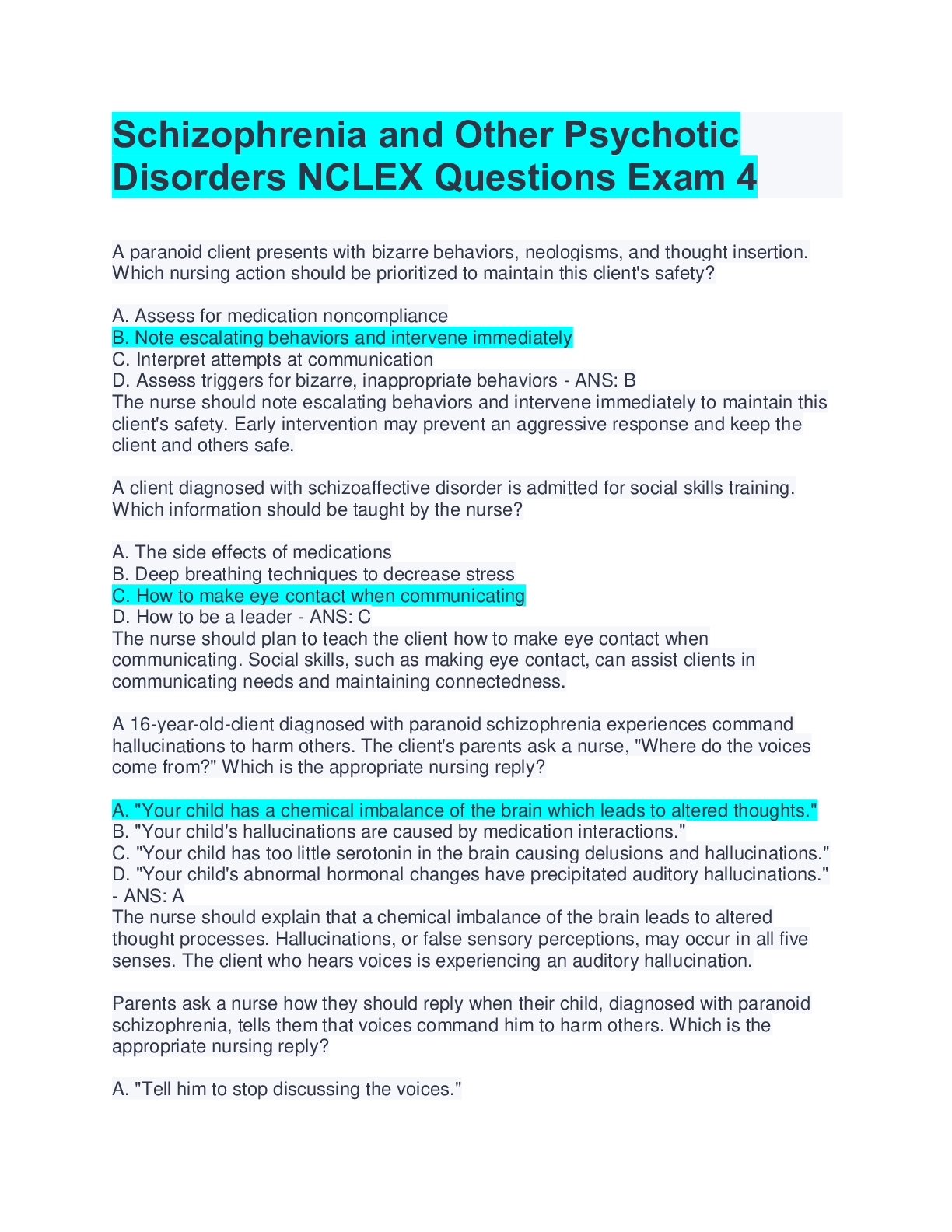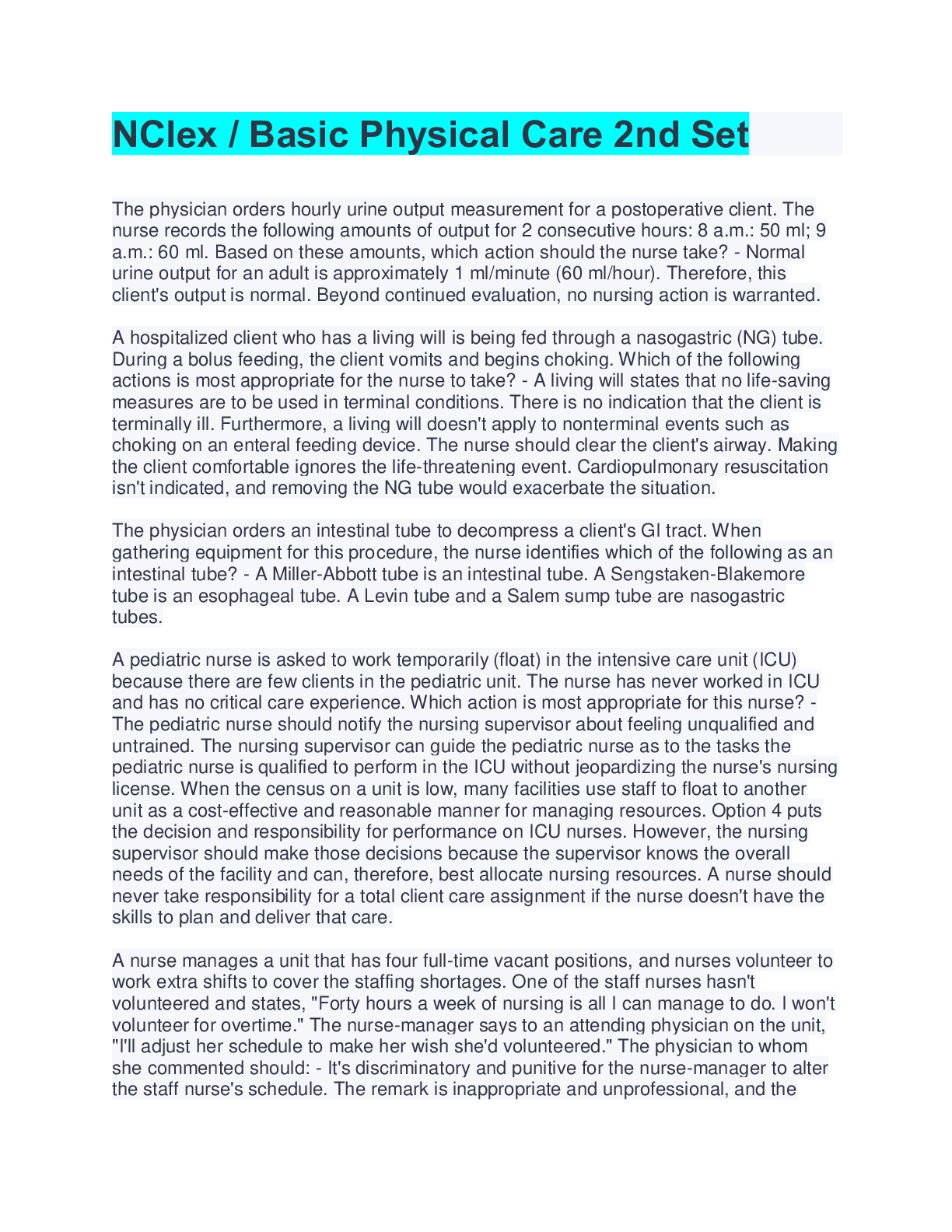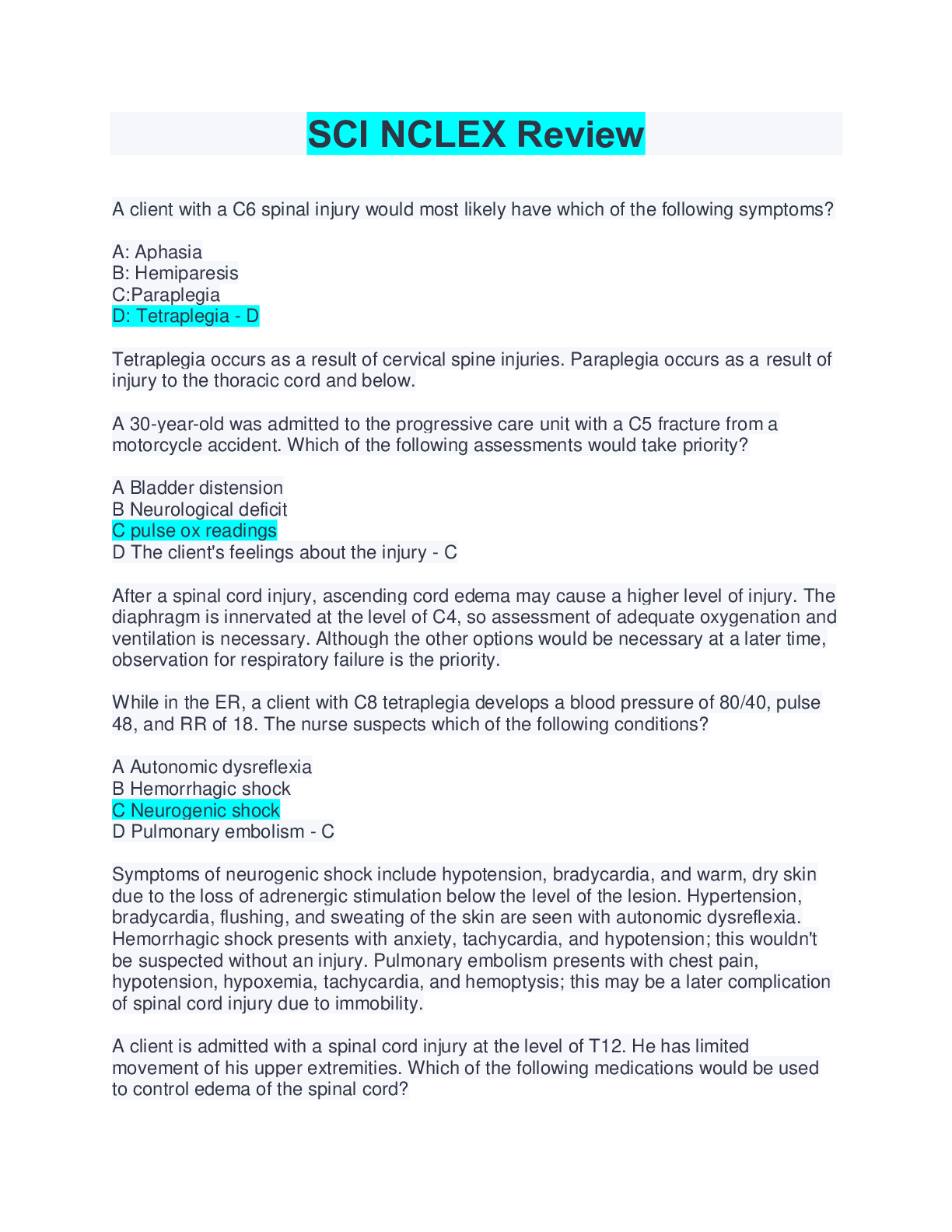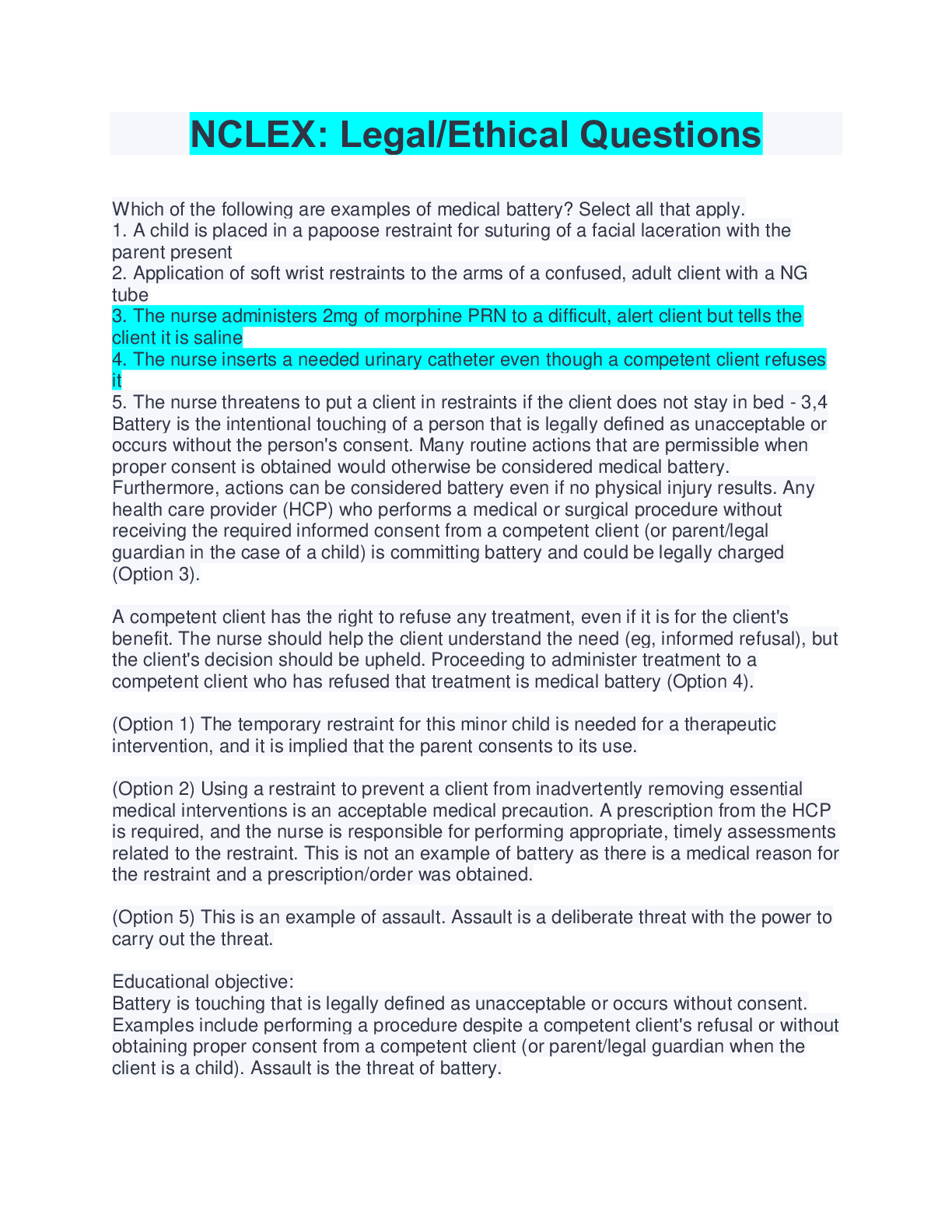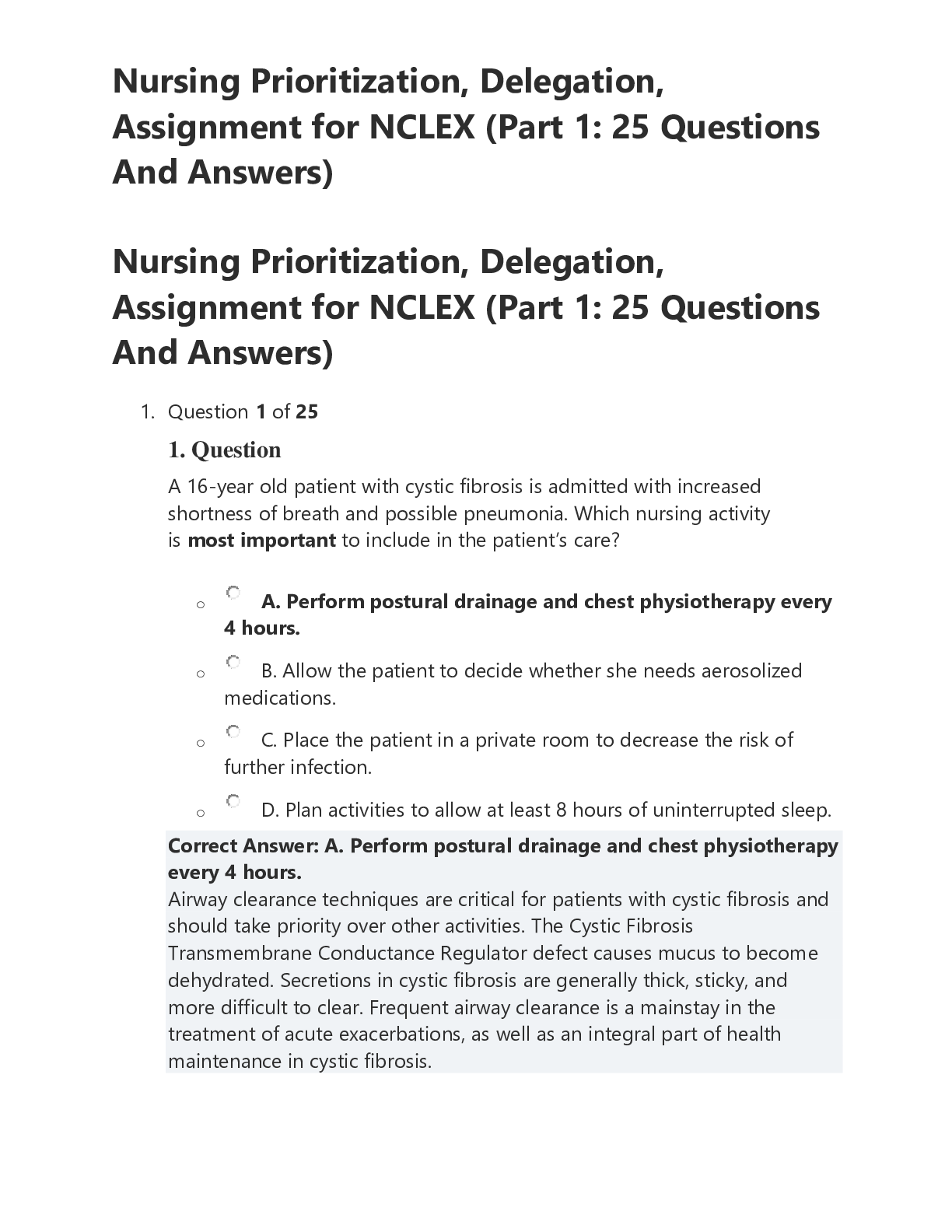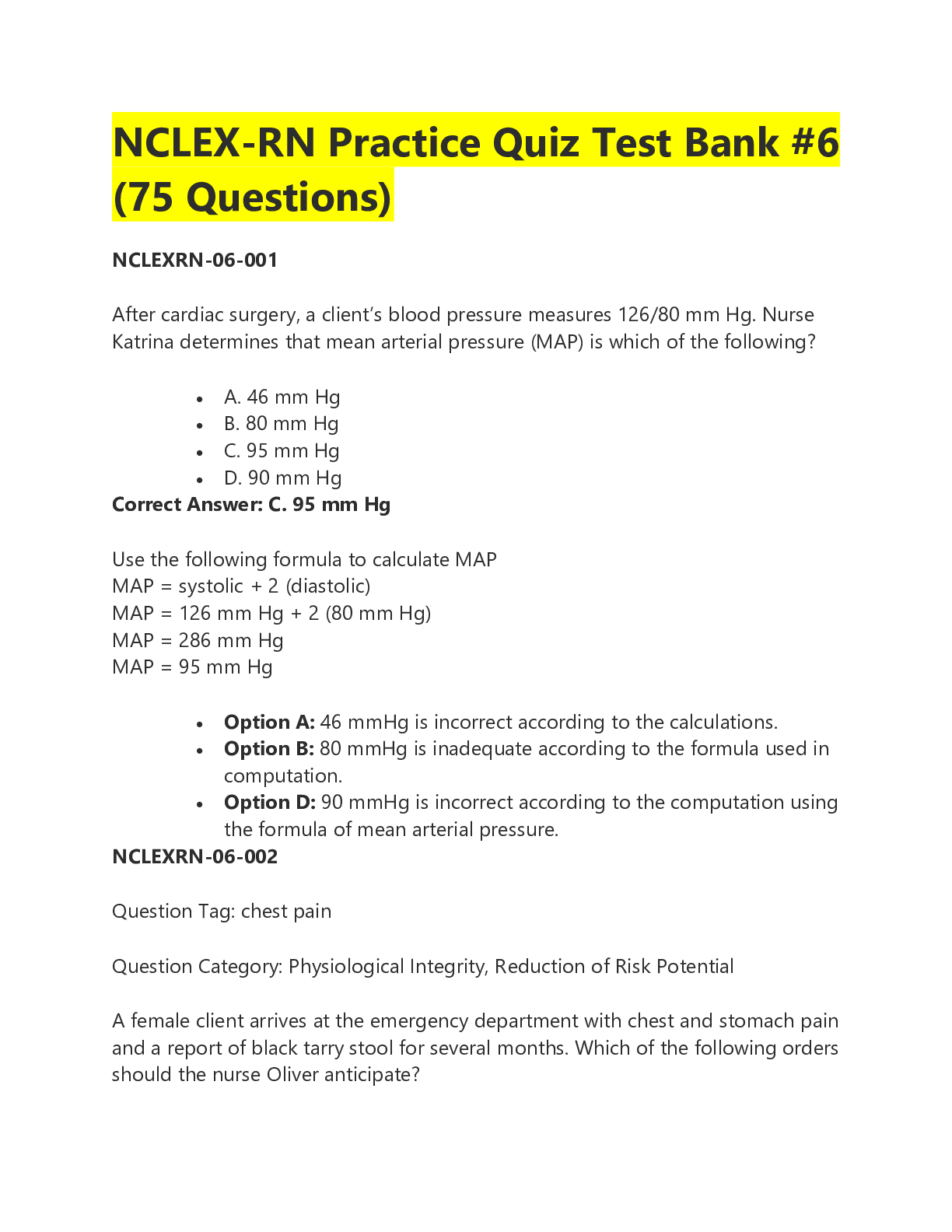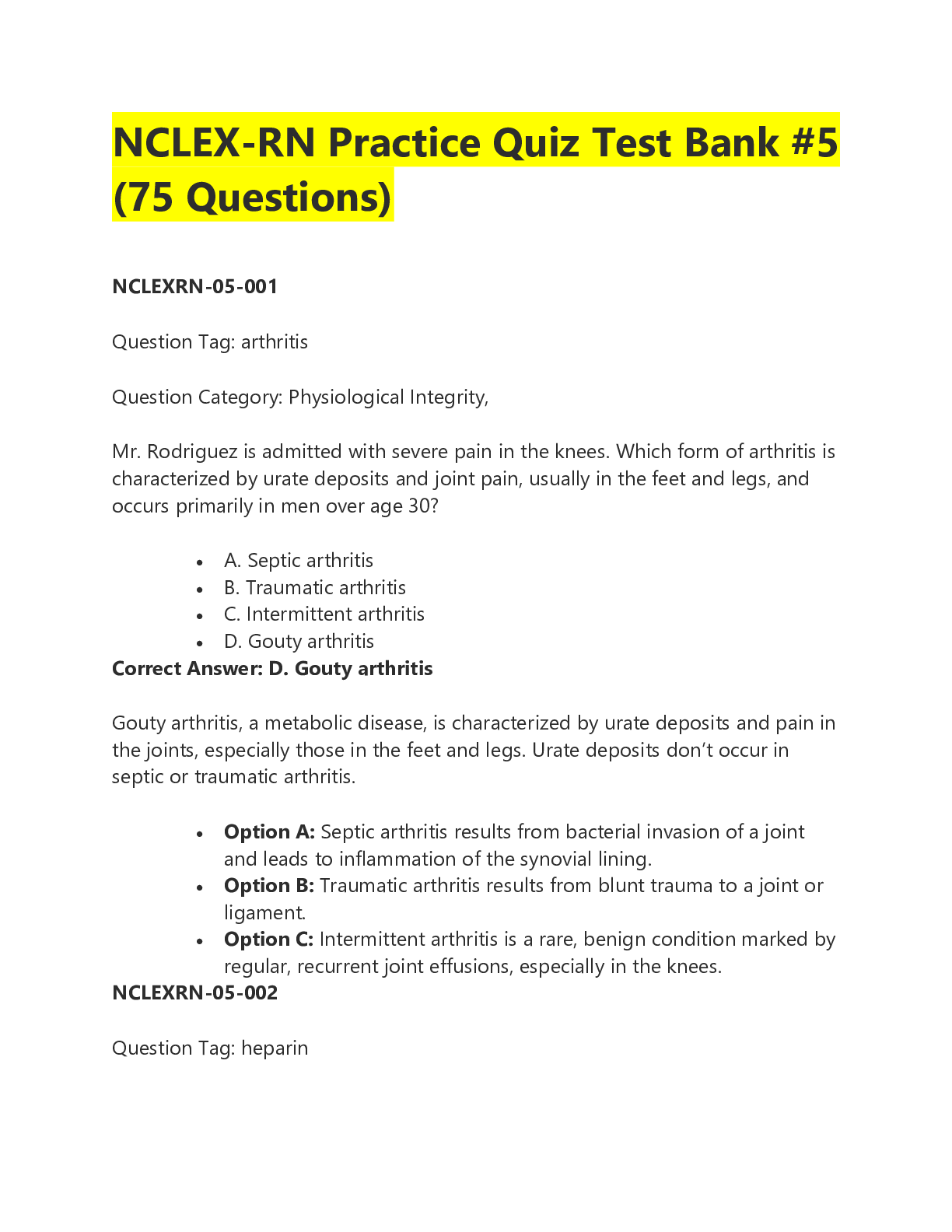*NURSING > NCLEX > Touhy & Jett: Ebersole and Hess’ Gerontological Nursing & Healthy Aging, 5th Edition/Chapter 13: R (All)
Touhy & Jett: Ebersole and Hess’ Gerontological Nursing & Healthy Aging, 5th Edition/Chapter 13: Rest, Sleep, and Activity
Document Content and Description Below
Chapter 13: Rest, Sleep, and Activity Touhy & Jett: Ebersole and Hess’ Gerontological Nursing & Healthy Aging, 5th Edition MULTIPLE CHOICE 1. Which of the following is a true statement abo... ut sleep in older adults? 2. Which of the following is a true statement about sleeping in older adults? 3. An older man has Alzheimer’s disease, and his wife says he is up and wandering around the house at night. Which intervention should the nurse implement to increase the man’s duration of 4. Exercises are prescribed for older adults as therapy to improve which one of the following qualities? 5. During the night, an older woman complains to the nurse that she has not slept more than 2 hours since admission to the hospital. Which intervention should the nurse implement to increase the duration of this woman’s sleep? 6. What is the difference between rest and sleep? 7. An older woman maintains an active lifestyle playing various games with friends. She reports to the nurse that she experiences wakefulness during the night and an inability to fall asleep after waking up at night. Which intervention should the nurse implement to improve the quality of this woman’s sleep? 8. The nurse completes an admission assessment on an older adult patient. The nurse identifies which factor that may contribute to sleep problems? 9. The nurse at an assisted-living facility uses the Exercise and Screening for You (EASY) tool to plan an exercise program for a female resident who is in good health except that her height has decreased inch. Which exercise safety tip from EASY calls for the nurse to assess the resident before planning care? a. Do not exercise a red, warm, or swollen joint. b. Avoid stretches that cause you to bend at the waist. c. Evaluate your surroundings for outdoor exercising. d. Begin by warming up with low- to moderate-intensity exercises. ANS: B The nurse needs more information because the reason the resident’s height has decreased is not known. Therefore, to obtain the information, the nurse decides to complete a resident assessment before planning an exercise program. The shrinkage can be due to atrophy of intervertebral disks, compression fractures, or changes in the curvature of the spine, any of which can be aggravated by incorrectly exercising. With a complete assessment, however, the nurse can plan a suitable exercise program for the resident. Red, warm, swollen joints are usually caused by gout or rheumatoid arthritis; fortunately, the resident does not have these health problems. However, this is a good recommendation for anyone who exercises. Evaluating an individual’s surroundings when exercising does not alert the nurse who is considering an exercise plan for this resident; however, this is a good, general recommendation for anyone who exercises. Warming up with low- to moderate-intensity exercises is a good recommendation for anyone who exercises. PTS: 1 DIF: Apply REF: p. 179 TOP: Nursing Process: Assessment MSC: Health Promotion and Maintenance 10. A patient who reported “a prNobUleRmSsIleNepGinTgB” .shCowOsMan understanding of good sleep hygiene a. doing 10 pushups before bed to encourage a “pleasant tiredness.” b. seldom eating a bedtime snack. c. engaging in computer games as a prebed activity. d. limiting the afternoon nap to just 30 minutes. ANS: D Limiting daytime napping to 30 minutes or less is a good sleep hygiene practice. Exercise should be completed at least 4 hours before retiring while bedtime snack is acceptable if the food is light and so easily digested. Computer-focused activities are not generally encouraged as a part of a bedtime routine. PTS: 1 DIF: Apply REF: p. 174 TOP: Teaching and Learning MSC: Health Promotion and Maintenance 11. When an older adult patient is diagnosed with restless leg syndrome (RLS), the nurse is confident that patient education on the condition’s contributing factors has been effective when the patient states: a. “A warm bath at night instead of in the morning is my new routine.” b. “Eating a banana at breakfast assures me the potassium I need.” c. “I’ve cut way back on my caffeinated coffee, teas, and sodas.” d. “I elevate my legs on a pillow to improve circulation.” ANS: C Increased caffeine use can be a contributing factor to RLS. There is no research to confirm that a warm bath before sleep or elevating the legs will minimize or prevent RLS. Potassium deficiency has not been identified as a contributing factor to RLS. PTS: 1 DIF: Apply REF: p. 177 TOP: Teaching and Learning MSC: Health Promotion and Maintenance 12. An older patient asks a nurse, “I really have trouble sleeping, and my doctor does not want to prescribe a sleeping pill for me. He says they are not good for older people. I really don’t understand his response. Can you help me?” The best response by the nurse is: a. “Sleeping medications have many adverse effects in older people and only have minimal effects in improving sleep.” b. “Prescription sleeping medications have many adverse effects in older people. Why don’t you try using an over-the-counter medication?” c. “Sleeping medications do not provide any improvement in sleep for older people.” d. “Sleep problems are common in older people. There really is nothing that you can do to help with that.” ANS: A Adverse effects of sleep medications, including over-the-counter medications, include problems with daily function, changes in mental status, motor vehicle accidents, daytime drowsiness, and increased risk of falls with only minimum improvement in sleep. Sleep problems are common in older adults; however, many nonpharmacologic interventions can be used to improve sleep. PTS: 1 DIF: Apply REF: p. 175 TOP: Teaching and Learning MSC: Health Promotion and Maintenance NURSINGTB.COM 13. A 75-year-old woman asks a nurse, “I know I should be moving, but how much is the right amount of exercise for me?” The best response of the nurse is: a. “You need to engage in 30 minutes of moderate intensity exercise on at least 5 days a week.” b. “You need to engage in at least 30 minutes of moderate-intensity exercise every day of the week.” c. “Because you are 75 years old, the recommendation is for 30 minutes of moderate-intensity exercise three times a week.” d. “There are no specific recommendations for someone of your age; just keep moving.” ANS: A Older adults need at least 2 hours and 30 minutes (150 minutes) of moderate-intensity aerobic activity (e.g., brisk walking, swimming, bicycling) every week and muscle-strengthening activities on 2 or more days that work all major muscle groups (legs, hips, abdomen, chest, shoulders, and arms). PTS: 1 DIF: Remember REF: p. 180 TOP: Teaching and Learning MSC: Health Promotion and Maintenance 14. During a routine physical examination, the patient reports, “I have problems falling asleep at night. I regularly engage in vigorous exercise to tire myself every evening.” What response by the nurse is indicated? a. “Exercise is recommended and should be done immediately before bedtime to tire you out.” b. “Exercise should only be done in the morning; otherwise, it can ruin your sleep.” c. “A regular exercise regimen is helpful; it can deepen sleep, but it should not be done immediately before bedtime.” d. “Exercise is helpful, but vigorous exercise can lead to restless leg syndrome, which can contribute to insomnia.” ANS: D A regular exercise regimen, for those who are able, can deepen sleep, increase daytime arousal, and decrease depression. It is important, however, to avoid exercise before bedtime. Vigorous exercise is not a contributor to restless leg syndrome. PTS: 1 DIF: Apply REF: p. 174 TOP: Teaching and Learning MSC: Health Promotion and Maintenance MULTIPLE RESPONSE 1. The nurse observes that a male patient is snoring every night. Which should the nurse assess in this patient to diagnose the potential for sleep apnea? (Select all that apply.) a. Change in appetite b. Rituals for sleeping c. Number of daytime naps d. Headaches in the morning e. Irritability during the day f. Awakening during the night ANS: C, D, E, F NURSINGTB.COM The nurse asks the patient to evaluate how restorative or refreshing sleeping is for him; awakening unrefreshed is a risk factor for sleep apnea. In addition, morning headaches, daytime irritability and personality changes, and periods of nighttime wakefulness are all risk factors for sleep apnea. Changes in appetite and rituals for sleeping are rarely associated with an increased risk for sleep apnea. PTS: 1 DIF: Understand REF: p. 176 TOP: Nursing Process: Assessment MSC: Health Promotion and Maintenance 2. A nurse will be conducting an education session at the local senior citizen’s center on the importance of physical activity. Which activities should the nurse include as an example of moderate-intensity aerobic activity? (Select all that apply.) a. Biking b. Range of motion (ROM) c. Weight lifting d. Dancing ANS: A, D Biking and dancing incorporate large muscle groups and are classified as moderate-intensity aerobic activity. ROM exercises are classified as stretching activities. Weight lifting is considered an exercise that uses body weight and is a muscle-strengthening activity. PTS: 1 DIF: Understand REF: p. 179 TOP: Nursing Process: Planning MSC: Health Promotion and Maintenance 3. The nurse should encourage which of the following exercises to assist with balance for a patient who is at high risk for falls? (Select all that apply.) a. Tai Chi b. Use of resistance bands c. ROM activities d. Walking heel to toe ANS: A, D Tai Chi and walking heel to toe are considered balance exercises. The use of resistance bands is considered muscle strengthening, and ROM activities are considered stretching exercises. PTS: 1 DIF: Understand REF: p. 180 TOP: Nursing Process: Planning MSC: Health Promotion and Maintenance 4. An older adult who has a balance disorder and has sustained repeated falls is recommended to start an exercise program. Which of the following exercises would be most beneficial in improving balance in this individual? (Select all that apply.) a. Yoga b. Tai Chi c. Swimming d. Pilates e. Weight lifting ANS: A, B Yoga and Tai Chi are exercises that improve balance, as they use movements that improve the ability to maintain control ofNtheRbodIy oGver Bth.e CbaseMof support to avoid falling. Swimming, Pilates, and weight lifting do not do this. PTS: 1 DIF: Remember REF: p. 180 TOP: Teaching and Learning MSC: Health Promotion and Maintenance [Show More]
Last updated: 1 year ago
Preview 1 out of 7 pages
Instant download

Buy this document to get the full access instantly
Instant Download Access after purchase
Add to cartInstant download
Reviews( 0 )
Document information
Connected school, study & course
About the document
Uploaded On
Aug 08, 2021
Number of pages
7
Written in
Additional information
This document has been written for:
Uploaded
Aug 08, 2021
Downloads
0
Views
66


